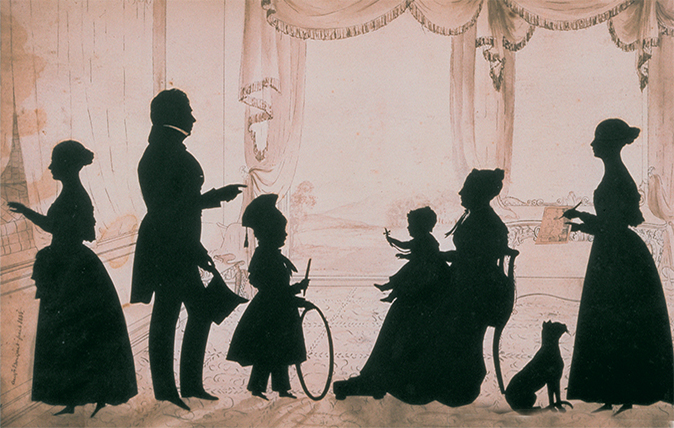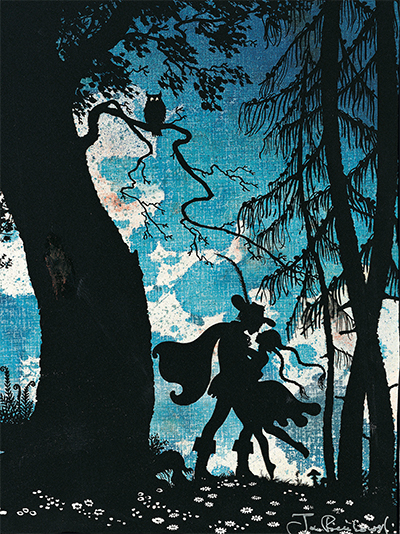The art of the silhouette
Before the advent of photography, portraits in the form of detailed silhouettes were all the rage


By Matthew Dennison
A silhouette, such as the one above of the Camsie family of O’Harrabrook, Co Antrim, by Augustin Edouart (1838), were an affordable alternative to a painted portrait.
Striking and distinctive, small-scale silhouettes form an element of many country-house portrait collections: handsome, monochrome mementos of once-loved profiles. The history of this intricate artform is equally arresting.
In 1785, the London studio of Isabella Beetham, at 27, Fleet Street, was a noisy place. From the lower floors of the same building, Mrs Beetham’s husband sold wooden mangles, a design of his own patenting. It wasn’t laundry, however, that concerned Mrs Beetham. She was among the leading portraitists of the day. Her medium wasn’t oils and her style lacked the bombast or swagger of her better-known male counterparts.
Mrs Beetham was a silhouette-maker—in the language of the time, a ‘profilist’. She created small-scale, mostly single-colour portrait likenesses, prized for their accuracy as well as detailed depictions of fashionable clothing, millinery and hairdressing. Her first portraits, undertaken in the 1770s, were simple cut-paper or card profiles in black on white; later, she progressed to more complex images painted on ivory, plaster or glass using soot- and charcoal-based pigments of varying densities.

A portrait of an unknown woman painted on glass by Mrs Beetham in the 1790s, in the V&A’s collection, captures with wonderful artistry, not only the sitter’s elaborate hat and ruched fichu, but something of the decisiveness of her handsome profile.
The fashion for ‘profiles’ or ‘shades’ grew throughout the 1770s as one of many offshoots of neo-Classical taste boosted by widespread interest in the archaeological digs at Herculaneum and Pompeii and may also have benefited from an association in the minds of British connoisseurs with classical intaglio carving and the black profiles of ancient Etruscan and Greek pottery.
Exquisite houses, the beauty of Nature, and how to get the most from your life, straight to your inbox.
Simplified likenesses, showing few of a sitter’s features and little of their age, expression or even personality, suggested the nobility of Classical bust portraiture in miniature. The fashion also gained a spur from the publication, in 1775, of Johann Kaspar Lavater’s Essays on Physiognomy, in which the author used simple black profile portraits to illustrate his thesis about identifying character from dominant physical features. Profilists made capital from the speed of their lifelike image-making process. Conventional painted portraits required lengthy sittings, typically followed by a period of studio work by the artist. By contrast, a cut-paper ‘profile’ was the work of minutes.
Mrs Beetham’s leading competitor John Miers, who established his rival studio in the Strand in the late 1780s, boasted of sittings lasting as little as a single minute and never more than three minutes. Small wonder that he would become one of two silhouetteists later to claim to have cut 100,000 profiles over the course of their careers (the other was the French-born Augustin Amant Constant Fidèle Edouart, who came to England in 1814). In Miers’s case, he boasted of using a process that crucially ‘preserve[d] the most exact Symmetry and animated expression of the Features, much superior to any other Method’.
The silhouette was not, however, an 18th century innovation. In his 1st-century Natural History, Pliny the Elder preserved a story of a Corinthian potter’s daughter—named Butades, Dibutade or Dibutades— who traced her lover’s profile cast by candlelight on a wall before he departed for a journey. Given the valedictory nature of Butades’s portrait, accuracy must always have been uppermost among silhouettes’ attraction—arising, in this first instance, from the artist tracing a shadow rather than drawing freehand. Among claims on trade labels of W. Seville & Son, silhouette-cutters in the second quarter of the 19th century, was the simple boast: ‘In a few seconds, A Striking Likeness In Profile.’
The first recorded British use of the term ‘silhouette’ was in 1798. It was not a compliment. Sponsored by Madame de Pompadour, on March 4, 1759, Etienne de Silhouette was appointed Controller-General of Finances in Louis XV’s government.
Confronted by staggering national debts, Silhouette swiftly advocated drastic economies in the royal household and a tax on the nobility and aristocracy. His measures met widespread opposition and, within less than a year, he had retired from government. The former minister’s perceived miserliness resulted in the popularity of the phrase ‘à la Silhouette’, meaning ‘on the cheap’. Profile portraits were then among the cheapest likenesses available. One theory is that the silhouette is named after his enthusiasm for cutting profiles himself.
In Britain, the silhouette dominated affordable portraiture in the century before photography became widespread. Such a portrait of Jane Austen, in the collection of the National Portrait Gallery, is one of the best-known likenesses of the author; in the 1830s, Queen Victoria sat for a silhouette, probably by Benjamin Pearce.
Although photography effectively ousted the silhouette from the 1850s, illustrators, including Arthur Rackham and Jan Pienkowski, and, more recently, graphic designers have kept the artform alive. In the performing arts, work by mime artists and filmmakers such as Alfred Hitchcock acknowledges the singular impact of the unassuming silhouette.
Country Life is unlike any other magazine: the only glossy weekly on the newsstand and the only magazine that has been guest-edited by His Majesty The King not once, but twice. It is a celebration of modern rural life and all its diverse joys and pleasures — that was first published in Queen Victoria's Diamond Jubilee year. Our eclectic mixture of witty and informative content — from the most up-to-date property news and commentary and a coveted glimpse inside some of the UK's best houses and gardens, to gardening, the arts and interior design, written by experts in their field — still cannot be found in print or online, anywhere else.
